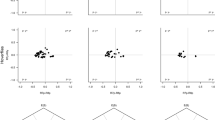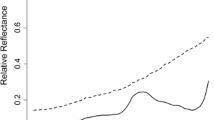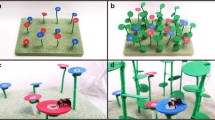Abstract
Alpine flowers face multiple challenges in terms of abiotic and biotic factors, some of which may result in selection for certain colours at increasing altitude, in particular the changing pollinator species composition, which tends to move from bee-dominated at lower elevations to fly-dominated in high-alpine regions. To evaluate whether growing at altitude—and the associated change in the dominant pollinator groups present—has an effect on the colour of flowers, we analysed data collected from the Dovrefjell National Park in Norway. Unlike previous studies, however, we considered the flower colours according to ecologically relevant models of bee and fly colour vision and also their physical spectral properties independently of any colour vision system, rather than merely looking at human colour categories. The shift from bee to fly pollination with elevation might, according to the pollination syndrome hypothesis, lead to the prediction that flower colours should shift from more bee-blue and UV-blue flowers (blue/violet to humans, i.e. colours traditionally associated with large bee pollinators) at low elevations to more bee-blue-green and green (yellow and white to humans—colours often linked to fly pollination) flowers at higher altitude. However, although there was a slight increase in bee-blue-green flowers and a decrease in bee-blue flowers with increasing elevation, there were no statistically significant effects of altitude on flower colour as seen either by bees or by flies. Although flower colour is known to be constrained by evolutionary history, in this sample we also did not find evidence that phylogeny and elevation interact to determine flower colours in alpine areas.






Similar content being viewed by others
References
Aceto S, Caputo P, Cozzolino S, Gaudio L, Moretti A (1999) Phylogeny and evolution of Orchis and allied genera based on ITS DNA variation: morphological gaps and molecular continuity. Mol Phylogenet Evol 13:67–76. doi:10.1006/mpev.1999.0628
Albert VA, Williams SE, Chase MW (1992) Carnivorous plants: phylogeny and structural evolution. Science 257:1491–1495. doi:10.1126/science.1523408
Altshuler DL (2003) Flower color, hummingbird pollination, and habitat irradiance in four Neotropical forests. Biotropica 35:344–355
Anderberg AA, Stahl B, Källersjö M (1998) Phylogenetic interrelationships in the Primulales inferred from cpDNA rbcL sequence data. Plant Syst Evol 211:93–102. doi:10.1007/BF00984914
Antonelli A (2008) Higher level phylogeny and evolutionary trends in Campanulaceae subfam. Lobelioideae: molecular signal overshadows morphology. Mol Phylogenet Evol 46:1–18. doi:10.1016/j.ympev.2007.06.015
Arnold SEJ, Savolainen V, Chittka L (2008) FReD: the floral reflectance spectra database. Nat Preced: doi: 10.1038/npre.2008.1846.1031
Arroyo MTK, Primack R, Armesto J (1982) Community studies in pollination ecology in the high temperate Andes of central Chile. I. Pollination mechanisms and altitudinal variation. Am J Bot 69:82–97. doi:10.2307/2442833
Backlund A, Bremer B (1997) Phylogeny of the Asteridae s.str. based on rbcL sequences with particular reference to the Dipsacales. Plant Syst Evol 207:225–254. doi:10.1007/BF00984390
Ben-Tal Y, King RW (1997) Environmental factors involved in colouration of flowers of Kangaroo Paw. Sci Hortic (Amsterdam) 72:35–48. doi:10.1016/S0304-4238(97)00071-X
Boeing WJ, Leech DM, Williamson CE, Cooke S, Torres L (2004) Damaging UV radiation and invertebrate predation: conflicting selective pressures for zooplankton vertical distribution in the water column of low DOC lakes. Oecologia 138:603–612. doi:10.1007/s00442-003-1468-0
Bradshaw HD Jr, Schemske DW (2003) Allele substitution at a flower colour locus produces a pollinator shift in monkey flowers. Nature 426:176–178. doi:10.1038/nature02106
Bremer K (2000) Early Cretaceous lineages of monocot flowering plants. Proc Natl Acad Sci USA 97:4707–4711. doi:10.1073/pnas.080421597
Briscoe AD (2000) Six opsins from the butterfly Papilio glaucus: molecular phylogenetic evidence for paralogous origins of red-sensitive visual pigments in insects. J Mol Evol 51:110–121
Briscoe AD, Bernard GD (2005) Eyeshine and spectral tuning of long wavelength-sensitive rhodopsins: no evidence for red-sensitive photoreceptors among five Nymphaline butterfly species. J Exp Biol 208:687–696. doi:10.1242/jeb.01453
Briscoe AD, Chittka L (2001) The evolution of colour vision in insects. Ann Rev Ent 46:471–510. doi:10.1146/annurev.ento.46.1.471
Cameron KM et al (1999) A phylogenetic analysis of the Orchidaceae: evidence from rbcL nucleotide sequences. Am J Bot 86:208–224. doi:10.2307/2656938
Chalker-Scott L (1999) Environmental significance of anthocyanins in plant stress responses. Photochem Photobiol 70:1–9. doi:10.1111/j.1751-1097.1999.tb01944.x
Chase MW et al (1993) Phylogenetics of seed plants: An analysis of nucleotide sequences from the plastid gene rbcL. Ann Mo Bot Gard 80:528–548+550–580
Chittka L (1992) The color hexagon: a chromaticity diagram based on photoreceptor excitations as a generalized representation of colour opponency. J Comp Physiol A Neuroethol Sens Neural Behav Physiol 170:533–543
Chittka L (1997) Bee color vision is optimal for coding flower color, but flower colors are not optimal for being coded—why? Isr J Plant Sci 45:115–127
Chittka L, Kevan PG (2005) Flower colour as advertisement. In: Dafni A, Kevan PG, Husband BC (eds) Practical pollination biology. Enviroquest Ltd., Cambridge, ON, Canada, pp 157–196
Chittka L, Menzel R (1992) The evolutionary adaptation of flower colors and the insect pollinators’ color vision systems. J Comp Physiol A Neuroethol Sens Neural Behav Physiol 171:171–181
Chittka L, Shmida A, Troje N, Menzel R (1994) Ultraviolet as a component of flower reflections, and the colour perception of Hymenoptera. Vision Res 34:1489–1508. doi:10.1016/0042-6989(94)90151-1
Chittka L, Thomson JD, Waser NM (1999) Flower constancy, insect psychology, and plant evolution. Naturwiss 86:361–377. doi:10.1007/s001140050636
Chittka L, Spaethe J, Schmidt A, Hickelsberger A (2001) Adaptation, constraint, and chance in the evolution of flower color and pollinator color vision. In: Chittka L, Thomson JD (eds) Cognitive ecology of pollination. Cambridge University Press, Cambridge, pp 106–126
Conti E, Soltis DE, Hardig TM, Schneider J (1999) Phylogenetic relationships of the silver saxifrages (Saxifraga, sect. Ligulatae Haworth): implications for the evolution of substrate specificity, life histories, and biogeography. Mol Phylogenet Evol 13:536–555. doi:10.1006/mpev.1999.0673
Cummings MP, Nugent JM, Olmstead RG, Palmer JD (2003) Phylogenetic analysis reveals five independent transfers of the chloroplast gene rbcL to the mitochondrial genome in angiosperms. Curr Genet 43:131–138
Desfeux C, Maurice S, Henry JP, Lejeune B, Gouyon PH (1996) Evolution of reproductive systems in the genus Silene. Proc R Soc Lond B Biol Sci 263:409–414. doi:10.1098/rspb.1996.0062
Dyer AG, Chittka L (2004) Biological significance of discriminating between similar colours in spectrally variable illumination: bumblebees as a study case. J Comp Physiol A Neuroethol Sens Neural Behav Physiol 190:105–114. doi:10.1007/s00359-003-0475-2
Faegri K, van der Pijl L (1978) The principles of pollination ecology. Pergamon Press, Oxford
Fineblum WL, Rausher MD (1997) Do floral pigmentation genes also influence resistance to enemies? The W locus in Ipomoea purpurea. Ecology 78:1646–1654
Fiz O, Vargas P, Alarcon M, Aedo C, Garcia JL, Aldasoro JJ (2008) Phylogeny and historical biogeography of Geraniaceae in relation to multiple major increases and decreases in mitochondrial climate changes and pollination ecology. Syst Bot 33:326–342. doi:10.1600/036364408784571482
Forest F et al (2007) Preserving the evolutionary potential of floras in biodiversity hotspots. Nature 445:757–760. doi:10.1038/nature05587
Friedman JW, Shmida A (1995) Pollination, gathering nectar and the distribution of flower species. J Theor Biol 175:127–138. doi:10.1006/jtbi.1995.0125
Giurfa M, Núñez J, Chittka L, Menzel R (1995) Colour preferences of flower-naive honeybees. J Comp Physiol A Neuroethol Sens Neural Behav Physiol 177:247–259
Gumbert A, Kunze J, Chittka L (1999) Floral colour diversity in plant communities, bee colour space and a null model. Proc R Soc Lond B Biol Sci 266:1711–1716. doi:10.1098/rspb.1999.0836
Guo H, et al. (2007) Identification of Radix Astragali by DNA sequence of its ITS, rbcL, matk, cox1, and NAD1-intron2. Direct submission: School of Traditional Chinese Materia Medica, Shenyang Pharmaceutical University, Shenyang, Liaoning 110016, China
Hansson LA (2000) Induced pigmentation in zooplankton: a trade-off between threats from predation and ultraviolet radiation. Proc R Soc Lond B Biol Sci 267:2327–2331. doi:10.1098/rspb.2000.1287
Hardie RC, Kirschfeld K (1983) Ultraviolet sensitivity of fly photoreceptors R7 and R8: evidence for a sensitising function. Biophys Struct Mech 9:171–180. doi:10.1007/BF00537814
Hosouchi T, Tsuruoka H, Kotani H (2007) Sequencing analysis of Draba nemorosa chloroplast DNA. Direct submission: NCBI Genome Project, National Centre for Biotechnology Information, NIH, Bethesda, MD 20894, USA
Inamura A, Ohashi Y, Sato E, Yoda Y, Masuzawa T, Yoshinaga K (1998) Intraspecific sequence variation of chloroplast DNA and a molecular phytogeographic study of Polygonum cuspidatum. Direct submission: Shizuoka University, Faculty of Science, Oya 836, Shizuoka 422–8529, Japan
Johnson ET, Berhow MA, Dowd PF (2008) Colored and white sectors from star-patterned Petunia flowers display differential resistance to corn earworm and cabbage looper. J Chem Ecol 34:757–765. doi:10.1007/s10886-008-9444-0
Jung YH, Han SH, Oh YS, Oh MY (2001). Direct submission: Department of Biology, College of Natural Sciences, Cheju National University, 1 Ara-Dong, Jeju 690–756, Korea
Kalisz S, Kramer EM (2008) Variation and constraint in plant evolution and development. Heredity 100:171–177. doi:10.1038/sj.hdy.6800939
Kearns CA (1992) Anthophilous fly distribution across an elevation gradient. Am Midl Nat 127:172–182. doi:10.2307/2426332
Kevan PG (1972) Floral colors in the high arctic with reference to insect-flower relations and pollination. Can J Bot 28:2289–2316. doi:10.1139/b72-298
Kevan PG, Baker HG (1983) Insects as flower visitors and pollinators. Ann Rev Ent 28:407–453. doi:10.1146/annurev.en.28.010183.002203
Kevan PG, Giurfa M, Chittka L (1996) Why are there so many and so few white flowers? Trends Plant Sci 1:280–284. doi:10.1016/1360-1385(96)20008-1
Kim KJ, Jansen RK (1995) ndhF sequence evolution and the major clades in the sunflower family. Proc Natl Acad Sci USA 92:10379–10383. doi:10.1073/pnas.92.22.10379
Kondo K, Terabayashi S, Okada M, Yuan C, He S (1996) Phylogenetic relationship of medicinally important Cnidium offcinale and Japanese Apiaceae besed on rbcL sequences. J Plant Res 109:21–27. doi:10.1007/BF02344283
Kron KA (2001). Direct submission: Wake Forest University, Winston-Salem, NC 27109–7325, USA
Kron KA, Chase MW (1993) Systematics of the Ericaceae, Empetraceae, Epacridaceae and related taxa based upon rbcL sequence data. Ann Mo Bot Gard 80:735–741. doi:10.2307/2399857
Kron KA, King JM (1996) Cladistic relationships of Kalmia, Leiophyllum and Loiseleuria (Phyllodoceae, Ericaceae) based on rbcL and nrITS data. Syst Bot 21:17–29. doi:10.2307/2419560
Kron KA, Judd WS, Crayn DM (1999) Phylogenetic analyses of Andromedeae (Ericaceae subfam. Vaccinioideae). Am J Bot 86:1290–1300. doi:10.2307/2656777
Lázaro A, Hegland SJ, Totland Ø (2008) The relationships between floral traits and specificity of pollination systems in three Scandinavian plant communities. Oecologia 157:249–257. doi:10.1007/s00442-008-1066-2
Levin RA et al (2003) Family-level relationships of Onagraceae based on chloroplast rbcL and ndhF data. Am J Bot 90:107–115. doi:10.3732/ajb.90.1.107
Li M et al (2008) Development of COS genes as universally amplifiable markers for phylogenetic reconstructions of closely related plant species. Cladistics 24:727–745. doi:10.1111/j.1096-0031.2008.00207.x
Lid J, Lid DT (2005) Norsk Flora, 7th edn. Det Norske Samlaget, Oslo
Lunau K, Maier EJ (1995) Innate colour preferences of flower visitors. J Comp Physiol A Neuroethol Sens Neural Behav Physiol 177:1–19
Lunau K, Wacht S, Chittka L (1996) Colour choices of naive bumble bees and their implications for colour perception. J Comp Physiol A Neuroethol Sens Neural Behav Physiol 178:477–489
Maddison WP, Maddison DR (1992) MacClade: analysis of phylogeny and character evolution. Sinauer Associates, Inc., Sunderland, MA
Manhart JR, Hugh JH, Wilson D (1991) Phylogeny of the Caryophyllales. Direct submission, GenBank
McCall C, Primack R (1992) Influence of flower characteristics, weather, time of day, and season on insect visitation rates in three plant communities. Am J Bot 79:434–442. doi:10.2307/2445156
Menzel R (1985) Learning in honey bees in an ecological and behavioral context. In: Hölldobler B, Lindauer M (eds) Experimental behavioral ecology, vol 31. Gustav Fischer Verlag, Stuttgart, pp 55–74
Menzel R, Shmida A (1993) The ecology of flower colours and the natural colour vision of insect pollinators: the Israeli flora as a study case. Biol Rev Camb Philos Soc 68:81–120. doi:10.1111/j.1469-185X.1993.tb00732.x
Morante J, Desplan C (2008) The color-vision circuit in the medulla of Drosophila. Curr Biol 18:553–565. doi:10.1016/j.cub.2008.02.075
Mori M, Yoshida Y, Matsunaga T, Nikaido O, Kameda K, Kondo T (2005) UV-B protective effect of a polyacylated anthocyanin, HBA, in flower petals of the blue morning glory, Ipomoea tricolor cv. Heavenly Blue. Bioorg Med Chem 13:2015–2020. doi:10.1016/j.bmc.2005.01.011
Muir G, Filatov D (2007) A selective sweep in the chloroplast DNA of dioecious Silene (section Elisanthe). Genetics 177:1239–1247. doi:10.1534/genetics.107.071969
Neumayer J, Spaethe J (2007) Flower color, nectar standing crop, and flower visitation of butterflies in an alpine habitat in central Europe. Entomol Gen 29:269–284
Olmstead RG, Michaels HJ, Scott KM, Palmer JD (1992) Monophyly of the Asteridae and identification of their major lineages inferred from DNA sequences of rbcL. Ann Mo Bot Gard 79:249–265. doi:10.2307/2399768
Panero JL, Funk VA (2008) The value of sampling anomalous taxa in phylogenetic studies: Major clades of the Asteraceae revealed. Mol Phylogenet Evol 47:757–782. doi:10.1016/j.ympev.2008.02.011
Peitsch D, Fietz A, Hertel H, de Souza J, Ventura DF, Menzel R (1992) The spectral input systems of hymenopteran insects and their receptor-based colour vision. J Comp Physiol A Neuroethol Sens Neural Behav Physiol 170:23–40
R Development Core Team (2004) R: a language and environment for statistical computing. R Foundation for Statistical Computing, Vienna, Austria
Raine NE, Chittka L (2007) The adaptive significance of sensory bias in a foraging context: floral colour preferences in the bumblebee Bombus terrestris. PLoS ONE 2:e556–e557. doi:10.1371/journal.pone.0000556
Raine NE, Ings TC, Dornhaus A, Saleh N, Chittka L (2006) Adaptation, genetic drift, pleiotropy, and history in the evolution of bee foraging behavior. Adv Stud Behav 36:305–354. doi:10.1016/S0065-3454(06)36007-X
Rodriguez-Girones MA, Santamaria L (2004) Why are so many bird flowers red? PLoS Biol 2:1515–1519. doi:10.1371/journal.pbio.0020350
Savile DBO (1972) Arctic adaptations in plants. In: Canada Department of Agriculture, Ottawa
Silvertown J et al (2006) Absence of phylogenetic signal in the niche structure of meadow plant communities. Proc R Soc Lond B Biol Sci 273:39–44. doi:10.1098/rspb.2005.3288
Sison-Mangus MP, Bernard GD, Lampel J, Briscoe AD (2006) Beauty in the eye of the beholder: the two blue opsins of lycaenid butterflies and the opsin gene-driven evolution of sexually dimorphic eyes. J Exp Biol 209:3079–3090. doi:10.1242/jeb.02360
Skorupski P, Döring TF, Chittka L (2007) Photoreceptor spectral sensitivity in island and mainland populations of the bumblebee, Bombus terrestris. J Comp Physiol A Neuroethol Sens Neural Behav Physiol 193:485–494
Sollid JL, Isaksen K, Eiken T, Ødegård RS (2003) The transition zone of mountain permafrost on Dovrefjell, southern Norway. In: 8th International Conference on Permafrost, vol. 1–2, Zürich, Switzerland, pp 1085–1089
Soltis DE, Morgan DR, Grable A, Soltis PS, Kuzoff R (1993) Molecular systematics of Saxifragaceae sensu stricto. Am J Bot 80:1056–1081. doi:10.2307/2445753
Soltis PS, Soltis DE, Chase MW (1999) Angiosperm phylogeny inferred from multiple genes as a tool for comparative biology. Nature 402:402–404. doi:10.1038/46528
Soltis DE et al (2001) Elucidating deep-level phylogenetic relationships in Saxifragaceae using sequences for six chloroplastic and nuclear DNA regions. Ann Mo Bot Gard 88:669–693. doi:10.2307/3298639
Swensen SM (1996) The evolution of actinorhizal symbioses: evidence for multiple origins of the symbiotic association. Am J Bot 83:1503–1512. doi:10.2307/2446104
Swofford DL (2002) PAUP*: phylogenetic analysis using parsimony (*and other methods). Sinauer Associates, Inc., Sunderland, MA
Tastard E, Andalo C, Giurfa M, Burrus M, Thébaud C (2008) Flower colour variation across a hybrid zone in Antirrhinum as perceived by bumblebee pollinators. Arthropod-Plant Interact 2:237–246. doi:10.1007/s11829-008-9046-3
Tokuoka T (2008) Molecular phylogenetic analysis of Violaceae (Malpighiales) based on plastid and nuclear DNA sequences. J Plant Res 121:253–260. doi:10.1007/s10265-008-0153-0
Totland Ø (1992) Pollination ecology in alpine plant communities in southern Norway: effect of abiotic and biotic factors on insect visitation and interspecific interactions. University of Bergen, Norway
Totland Ø (1993) Pollination in alpine Norway: flowering phenology, insect visitors, and visitation rates in two plant communities. Can J Bot 71:1072–1079
Totland Ø, Eide W, Grytnes JA (2000) Is there a typical alpine flower? In: Totland Ø (ed) The Scandinavian association for pollination ecology honours Knut Fægri, vol 1. Det Norske Videnskaps-Akademi, Oslo, pp 139–148
Trift I, Källersjö M, Anderberg AA (2002) The monophyly of Primula (Primulaceae) evaluated by analysis of sequences from the chloroplast gene rbcL. Syst Bot 27:396–407
Troje N (1993) Spectral categories in the learning behaviour of blowflies. Z Naturforsch 48c:96–104
Vázquez DP, Morris WF, Jordano P (2005) Interaction frequency as a surrogate for the total effect of animal mutualists on plants. Ecol Lett 8:1088–1094. doi:10.1111/j.1461-0248.2005.00810.x
Wagstaff SJ, Bayly MJ, Garnock-Jones PJ, Albach DC (2002) Classification, origin, and diversification of the New Zealand hebes (Scrophulariaceae). Ann Mo Bot Gard 89:38–63. doi:10.2307/3298656
Wang W, Li R-Q, Chen Z-D (2005) Systematic position of Asteropyrum (Ranunculaceae) inferred from chloroplast and nuclear sequences. Plant Syst Evol 255:41–54. doi:10.1007/s00606-005-0339-z
Warren J, Mackenzie S (2001) Why are all colour combinations not equally represented as flower-colour polymorphisms? New Phytol 151:237–241. doi:10.1046/j.1469-8137.2001.00159.x
Waser NM (1983) The adaptive nature of floral traits: ideas and evidence. In: Real LA (ed) Pollination biology. Academic Press, New York, pp 241–285
Weevers T (1952) Flower colours and their frequency. Acta Bot Neerl 1:81–92
West W, West GS (1910) Sketches of vegetation at home and abroad. V. The ecology of the Upper Driva Valley in the Dovrefjeld. New Phytol 9:353–374. doi:10.1111/j.1469-8137.1910.tb05557.x
Whibley AC et al (2006) Evolutionary paths underlying flower color variation in Antirrhinum. Science 313:963–966. doi:10.1126/science.1129161
Yasui Y, Ohnishi O (1996) Comparative study of rbcL gene sequences in Fagopyrum and related taxa. Genes Genet Syst 71:219–224. doi:10.1266/ggs.71.219
Acknowledgements
The raw data for this study were collected when LC worked under the auspices of the Institute of Neurobiology, Free University of Berlin. Financial support came from a Leibniz Award from the German Research Foundation (DFG) to R. Menzel. We wish to thank Simen Bretten for help with identification of the plants, and Neal Williams and three anonymous reviewers for their helpful comments on the manuscript. SEJA was supported by a Biotechnology and Biological Sciences Research Council/Co-operative Award in Science and Engineering (CASE) studentship in association with Kew Enterprises (BBS/S/L/2005/12155A).
Author information
Authors and Affiliations
Corresponding author
Additional information
Handling editor: Neal Williams
Appendix
Appendix
Rights and permissions
About this article
Cite this article
Arnold, S.E.J., Savolainen, V. & Chittka, L. Flower colours along an alpine altitude gradient, seen through the eyes of fly and bee pollinators. Arthropod-Plant Interactions 3, 27–43 (2009). https://doi.org/10.1007/s11829-009-9056-9
Received:
Accepted:
Published:
Issue Date:
DOI: https://doi.org/10.1007/s11829-009-9056-9




